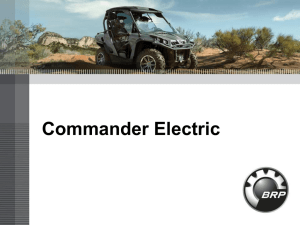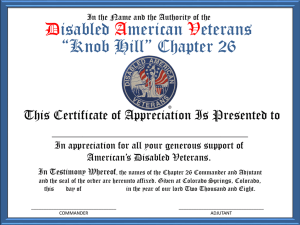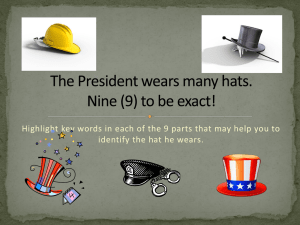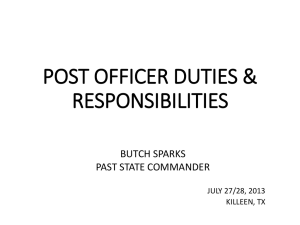Joint and Combined Command and Control
advertisement
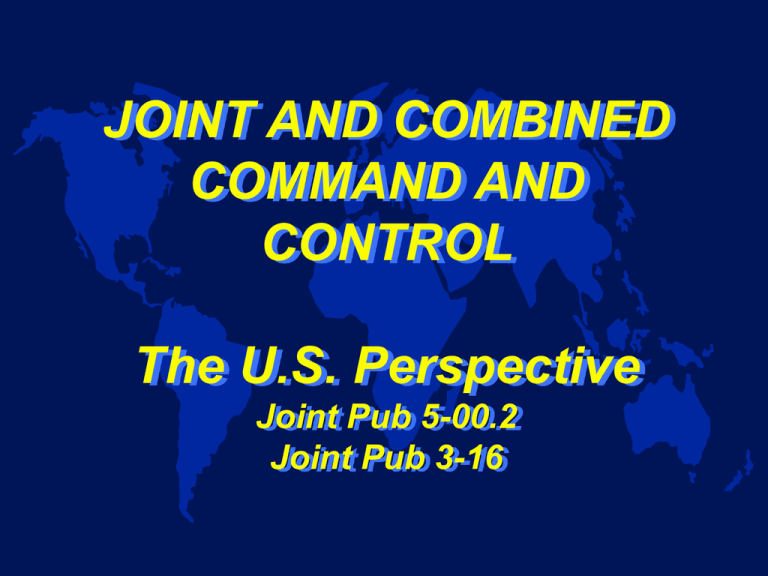
JOINT AND COMBINED COMMAND AND CONTROL The U.S. Perspective Joint Pub 5-00.2 Joint Pub 3-16 Building New Command and Control Relationships Joint-ness legally mandated at the strategic, operational and tactical levels At Issue: Definition / separation of “command” and “operational” responsibilities – – Moving from the traditional concept of “command” To the concept of Command that delineates between operational and administrative control responsibilities and doesn’t presume both functions have to be performed by the same commander (or even the same service) and chain of command. Command Relationships Combatant Command Authority - COCOM (Strategic Level of Warfare) (1) Exercised by a unified or specified commander appointed by the President with a broad continuing mission (regional or functional) • Cannot be delegated (2) Authoritative direction for all Military Operations, joint training and logistics necessary to accomplish assigned missions • Organize and employ Commands and Forces • Assigns tasks and designation of objectives (3) Normally exercised through subordinate Joint task force or functional component commanders Command Relationships Operational Control - OPCON (Operational or Tactical Levels of Warfare) (1) Inherent in Combatant Command Authority (2) Authoritative direction for all Military Operations and Training • Organize and employ Commands and Forces • Assigns tasks and designation of objectives (3) Normally exercised through subordinate Joint task force or functional component commanders •Suspend / reassign subordinate commanders (4) Does not include authoritative direction for logistics, admin, discipline, unit training or internal organization Command Relationships Tactical Control - TACON (Operational or Tactical Levels of Warfare) • Inherent in OPCON • Detailed local direction and control of movements • Typical in functional command structures • Does not include: – organizational authority – administrative and logistics support Command Relationships Support - established by a superior joint commander when one organization should aid, protect, complement, or sustain another. Answers directly to supported force’s request for assistance • Provides an effective means to weight (and ensure unity of effort) for various operations Supported commander Command Relationships Support - established by a superior joint commander when one organization should aid, protect, complement, or sustain another. Answers directly to supported force’s request for assistance • Provides an effective means to weight (and ensure unity of effort) for various operations Supported commander designates and prioritizes determines timing and duration of support determines other coordination requirements Command Relationships Supporting Commander Types of Support Command Relationships Supporting Commander Retains OPCON of assigned forces Prescribes tactics, methods, communications, and procedures Coordinates with the supported commander Keeps the supported commander informed Provides LNOs to supported commander Types of Support Command Relationships Supporting Commander Retains OPCON of assigned forces Prescribes tactics, methods, communications, and procedures Coordinates with the supported commander Keeps the supported commander informed Provides LNOs to supported commander Types of Support Mutual Support - unit support to each other General Support - support provided to an entire force Direct Support - direct responsibility to another force Close Support - “supporting” force activities sufficiently near the “supported” force Other Authorities Administrative Control Includes organization of service forces, control of resources and equipment, personnel management, unit log, readiness, discipline and other matters not included in operational missions. Subject to command authorities of combatant commanders Coordinating Authority A consultation relationship. The authority to require, but not compel, agreement. More applicable to planning and similar activities. Direct Liaison Authorized (DIRLAUTH) The authority to coordinate or consult with agencies inside or outside the granting command Command Relationships “... there should be no mistaking the fact that the greatest obstacles to unity of command during UNOSOM II were imposed by the United States on itself . . . command arrangements had effectively created a condition that allowed no one to set clear, unambiguous priorities in designing and executing a comprehensive force package.” Somalia Operations: Lessons Learned Jan 95, Page 60 JTF C2 Considerations Planning Stages - C2 arrangements and relationships during planning should be specified in the initiating directive Employment - C2 for employment should be clearly established in appropriate JTF, component and subordinate TF OPORDs Termination - Termination C2 should be addressed in planning from beginning Transition - C2 changes need to be anticipated in continuing operations Redeployment - C2 should remain with the CJTF until relieved of operational responsibilites JTF Component Structure (Service) CINC Capabilities or functions do not overlap Simplicity in a Time Compressed Environment JTF NAVFOR AFFOR ARFOR MARFOR JSOTF JTF Component Structure (Functional) Unity of Effort CINC Organize by capabilities or functions CJTF JFMCC JFACC JFLCC JSOTF JPOTF JCMOTF Subordinate TF Structure Unity of Effort CINC Geographic or Mission Specific CJTF TF TRANS TF MED TF Eng JSOTF JPOTF JCMOTF JFACC ? “The JFC will normally designate a JFACC. The JFC will base the decision to designate a JFACC on several factors such as:” – Mission – Concept of Operations – Tasks to Subordinate Units – Forces Available – Duration and Nature of Air Operations Desired – Degree of Unity of C2 of Joint Air Ops Required Combined or Multinational Force Operations JTF Organization Multinational Operations “Nothing that I have ever been taught prepared me for the mental jump needed to go from being Chief of Operations in NATO army group to being Chief of Staff of a UN Operation, where I had to bring together the staff from ten different nations and staff the deployment in less than three weeks from the Security Resolution.” Major General R.A. Cordy-Simpson UKAR C2 of US Forces in MNF Operations The U.S. President retains command authority over US forces. This includes the authority and responsibility for effectively using available resources and for planning employment, organizing, directing, coordinating, controlling and protecting military forces for the accomplishment of assigned missions C2 of US Forces in MNF Operations Command authority - never delegated OPCON (as defined by our doctrine) - may be delegated – – for small deployments on a case-by-case basis under UN auspices or ad hoc coalitions – mission cannot be changed forces cannot be deployed outside designated AOR units/resources cannot be separated or divided from each other US commanders are required to maintain the capability to report separately to higher US and foreign military authorities Coordinating authority - also an acceptable means of accomplishing a MNF “planning” mission MNF Command Structures No single command structure best fits the needs of all alliances (long term) and coalitions (short term) – should strive to achieve unity of command Alliance – – command structures integrated lead nation Coalition – – – command structures parallel command structures: least desirable lead nation combination “Integrated” Command Structure MULTINATIONAL FORCE COMMANDER CARFOR US ARFOR CNAVFOR Allied ARFOR US NAVFOR Allied NAVFOR DMFC CAFFOR US AFFOR Allied AFFOR When Used: Common Language, National Objectives, Good Interoperability “Lead Nation” Command Structure International Alliance Auth Combined CMD MULTINATIONAL FORCE COMMANDER Allied Command Allied Nation Other Components Allied Nation Army Component Nat’l COCOM U.S. Command U.S. Army Component U.S. Naval Component When Used: Significant Language or National Objective Differences or Poor Interoperability U.S. Air Force Component Lead Nation Concept in MultiNational Coalition Operations (MIC White Paper) The Multinational Interoperability Committee (MIC) provides a multinational environment for identifying and articulating actions which, if nationally accepted and implemented, would contribute to more effective coalition operations. It seeks to identify essential factors that the Lead Nation and the coalition commander and his staff should consider for the effectiveness and efficiency of the coalition. Lead Nation Concept Factors in the selection of a “Lead Nation” Lead Nation Concept Factors – in the selection of a “Lead Nation” Above all the Lead Nation must be a politically acceptable choice for the other coalition partners. Lead Nation Responsibilities Lead Nation Concept Factors – Above all the Lead Nation must be a politically acceptable choice for the other coalition partners. Lead – – – – – – in the selection of a “Lead Nation” Nation Responsibilities provide the command structure and strategic guidance coordinate for, create, or provide communications and information management structures lead the development of the coalition’s political objectives act as sponsor and spokesman for the coalition’s operations in the world community lead coordination and building of consensus during the coalition’s planning and execution phases be competent to carry out the anticipated operation Lead Nation Concept The most flexible and responsive command authority under which the coalition commander can act is to have national forces assigned to under his operational control (OPCON). least desirable command arrangement is a parallel command structure Lead Nation Concept Provide unity of command for the operation to the maximum extent possible, with missions, tasks, responsibilities, and authorities clearly defined and understood by all participants Although coalition participants may have similar political mandates, each nation is likely to bring to the coalition a different set of national Rules of Engagement (ROE) Lead Nation Concept The actual "mechanics" of this planning process will be vastly simplified if coalition partners provide a "Planning Liaison Cell(s)" early on which essentially can be "folded into" the Lead Nation’s planning process. The formation of a Planning Liaison Cell(s) will also facilitate this process by providing a mechanism for exchange of detailed information regarding the capabilities of each partner and the willingness and/or ability of each to commit resources. Lead Nation Concept The execution of coalition logistics is most effective if it is made a collective responsibility of the coalition force. When possible, mutual logistics support should be developed for economy of effort. Functional Lead nation for logistics responsibility can preclude duplication of effort. Once planning for a coalition operation has begun, the Commander of the multinational force must establish standard operating procedures (SOP) whenever appropriate. Lead Nation Concept Formation of a fully integrated command structure is most likely to achieve a high degree of unity of command. Combination command structures exist when both Lead Nation and parallel command structures exist simultaneously; this occurs when two or more nations serve as Lead Nation for a mix of multinational forces Lead Nation Concept Lead Nation command characterized by an integrated staff and multinational subordinate forces allowing the commander to draw upon the expertise of alliance partners in areas where the lead nation may have less experience. Demand a robust liaison structure to facilitate operations. Early establishment reduces the fog and friction caused by incompatible communications systems, doctrine, and operating procedures. Lead Nation Concept Coordination Centers can also facilitate control of multinational operations, which require interaction with a variety of agencies, both military and nonmilitary. A coordination center can assist in command and control as well as to organize and coordinate a variety of functions, including logistics and civilmilitary operations. A central coalition coordination center may be established as well as a number of functional coordination centers Lead Nation Concept As a minimum under any command arrangement a National Command Element (NCE) of some sort will be established for each national contingent, and will continue as a minimum to exercise administrative and other support functions during the operation. Lead Nation Concept Assignment of national forces under OPCON may be qualified from the respective nations. Further assignment in an OPCON status by the coalition force commander is normally subject to approval by the respective national command authorities. Details should normally be spelled out in a Transfer of Authority (TOA) agreement. JOINT AND COMBINED COMMAND AND CONTROL The U.S. Perspective Joint Pub 5-00.2 Joint Pub 3-16

